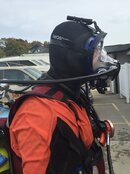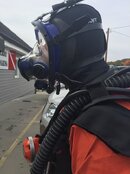Being a Public Safety Dive Team leader for 3 Dive Teams, and diving for another 4 teams, I am no stranger to the issues that come with using a full face mask. Dive Rite In Scuba 2 you are right in regards to the contamination factor that Public Safety Divers worry about. Unfortunately the only true way to seal out all contaminants is to use a latex hood. The level of contamination is where one decides what is sufficient to where (either latex or neoprene).
As of to date, one of our teams is currently using the Iron Mask by Ocean Reef, and Sea Soft FFM hoods. We do have a few divers myself included that prefer the latex attached hoods on the dry suits, but through a risk and analysis study we conducted and with the amount of calls (and type of calls), the hazmat concerns we face are minimum. As of to date, the majority of contamination we have faced is gas, oil, and etc. from vehicles. We have had a local city that connects to one of our water ways dump sewage (and charge thankfully), but this is normal for our local lake (most of us go in normal and come out glowing, we are going to start a new PADI course, called the Toxic Diver).
In personal use, I use the Ocean Reef standard Neptune Space G-Diver. With a custom hood (OS-Systems) I don't have an issue with getting a seal on top of the hood down to around 20 feet. Any deeper and I get to much compression on the neoprene and the mask begins to free flow. Cases like this, when I know I'm going deeper I will use the Sea Soft hood. Last year (2014) I conducted over 15 missions, ranging from evidence recovery, body recoveries (4 in 2014), to vehicle recoveries. Most were mid summer and I chose not to where a hood. During my scene size up, is when I determined which hood to wear. Just recently I conducted an investigation for our local Sheriff's Office, and a woman had called 911 and said her car was in the water. Long story short it had been in the water for 3 hours prior to calling 911. She tried to sink it and collect insurance money. Problem was it stopped in 3 feet of water and bottomed out. In this case where I simply walk in to 3 feet of water and hook a chain to the vehicle, I chose not to wear the Sea Soft hood and went with the OS System custom hood. I simply wore it for warmth and nothing else.
As far as communication goes, I have yet to have an issue with receiving (hearing) transmissions while wearing a hood. The biggest issue I have had, is divers just can't talk. Especially since most of ours are volunteer (FIREMAN, and yes I am a FIREMAN also so I feel comfortable picking on them). I was trained how to properly speak on the radio when I was in Law Enforcement, but most of our Fire Departments here are volunteer and most are not properly trained on how to communicate, and most get excited and scream into the mic.
I do have 1 of my Under Water Criminal Investigators who cut his hood so that the mask would seal against his skin and the hood would sit up against the skirt. This seams to work great for him, mainly because of his facial features. He was even able to hem the hood and make it look factory. All in all, I prefer to seal the mask on top of the hood, but whatever works for the individual diver that is what he should do, as long as it does not hinder him / her from removing and replacing the mask if the need arises or cause any malfunctions such as a free flow.
Here are some pictures and a video of some of our team members in action wearing the Full Face Mask and hoods.


[video=youtube;VrYBY9OXHOU]https://www.youtube.com/watch?v=VrYBY9OXHOU&list=PL4PpMS5GFUw3YY487mdcfEsM XFfjpCwJZ&index=3[/video]





